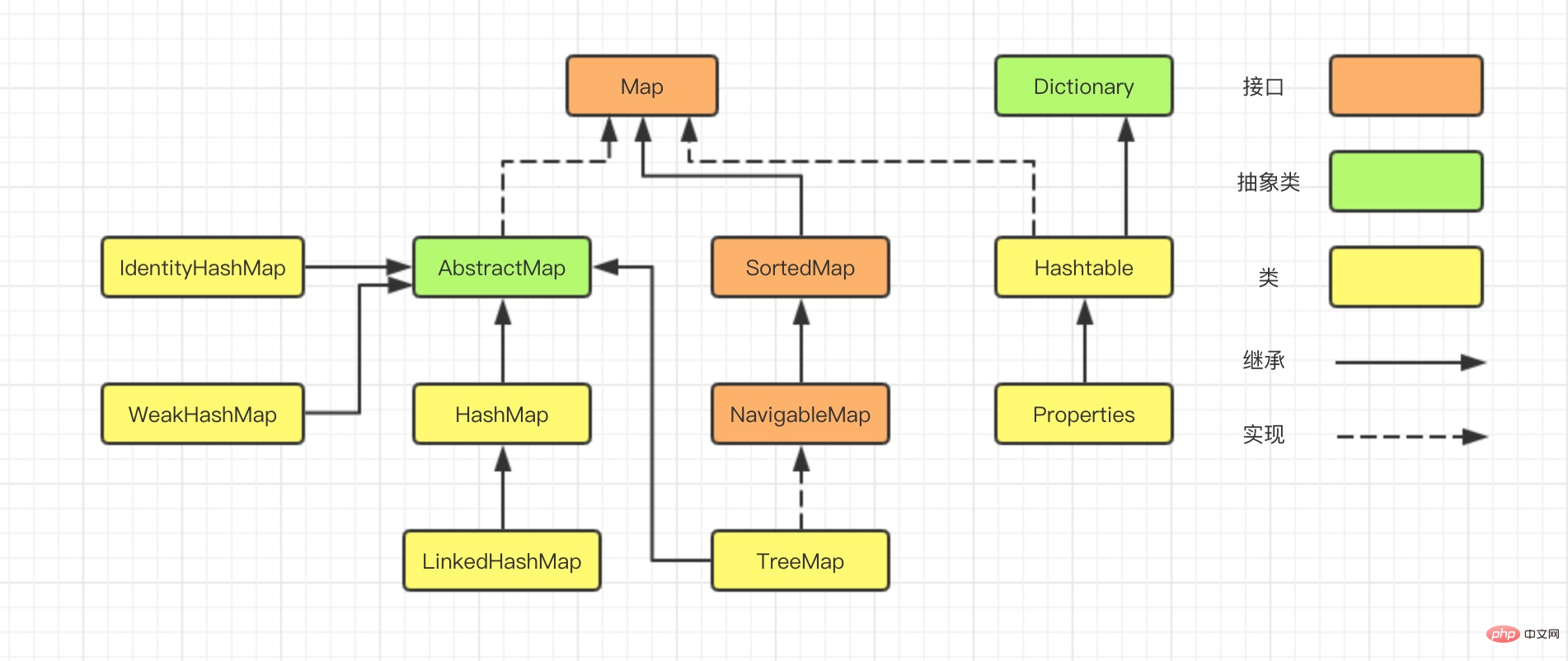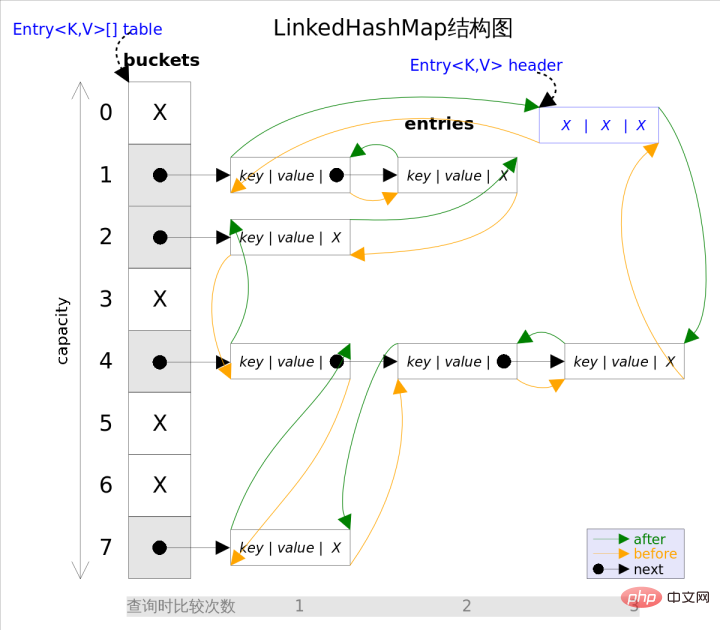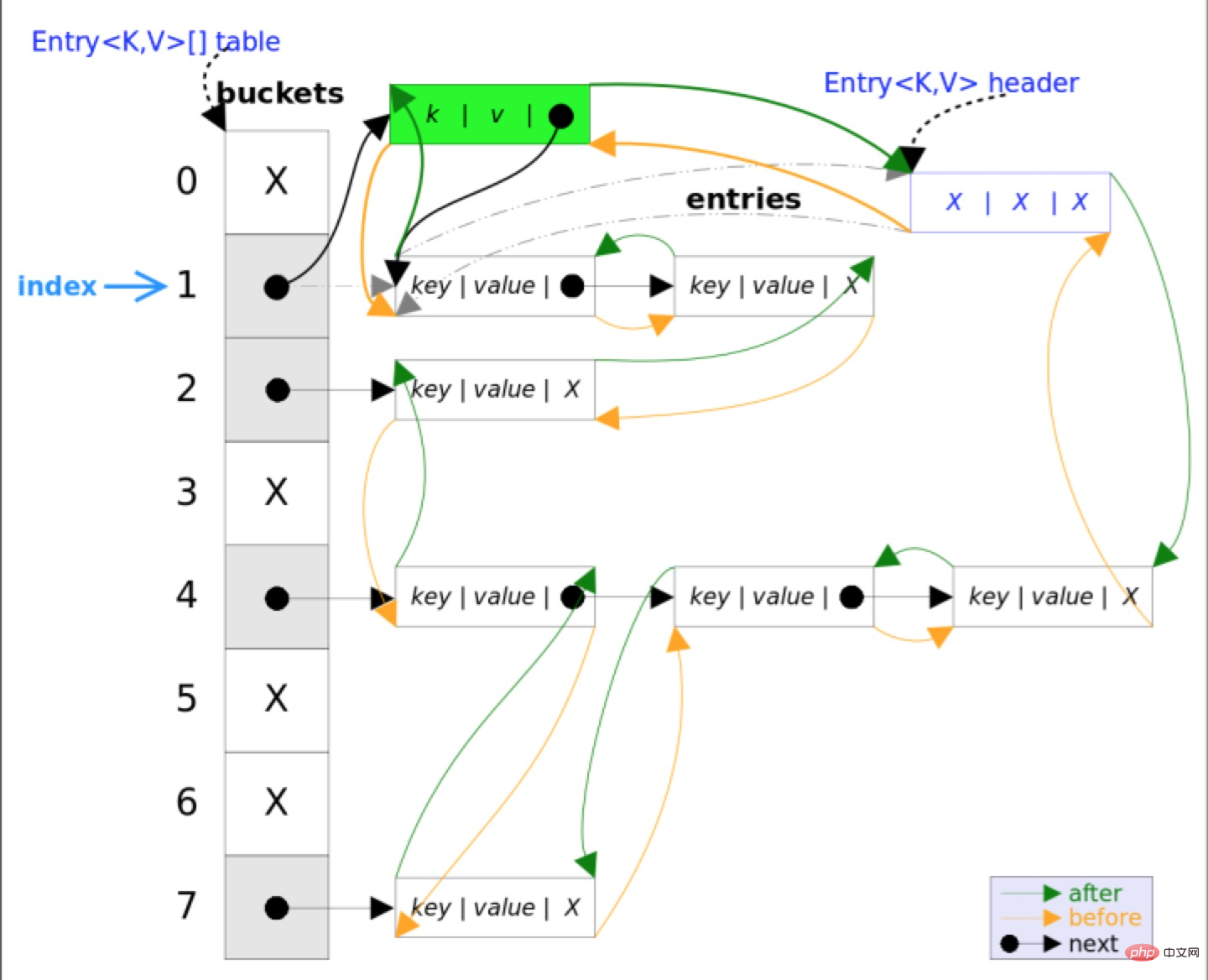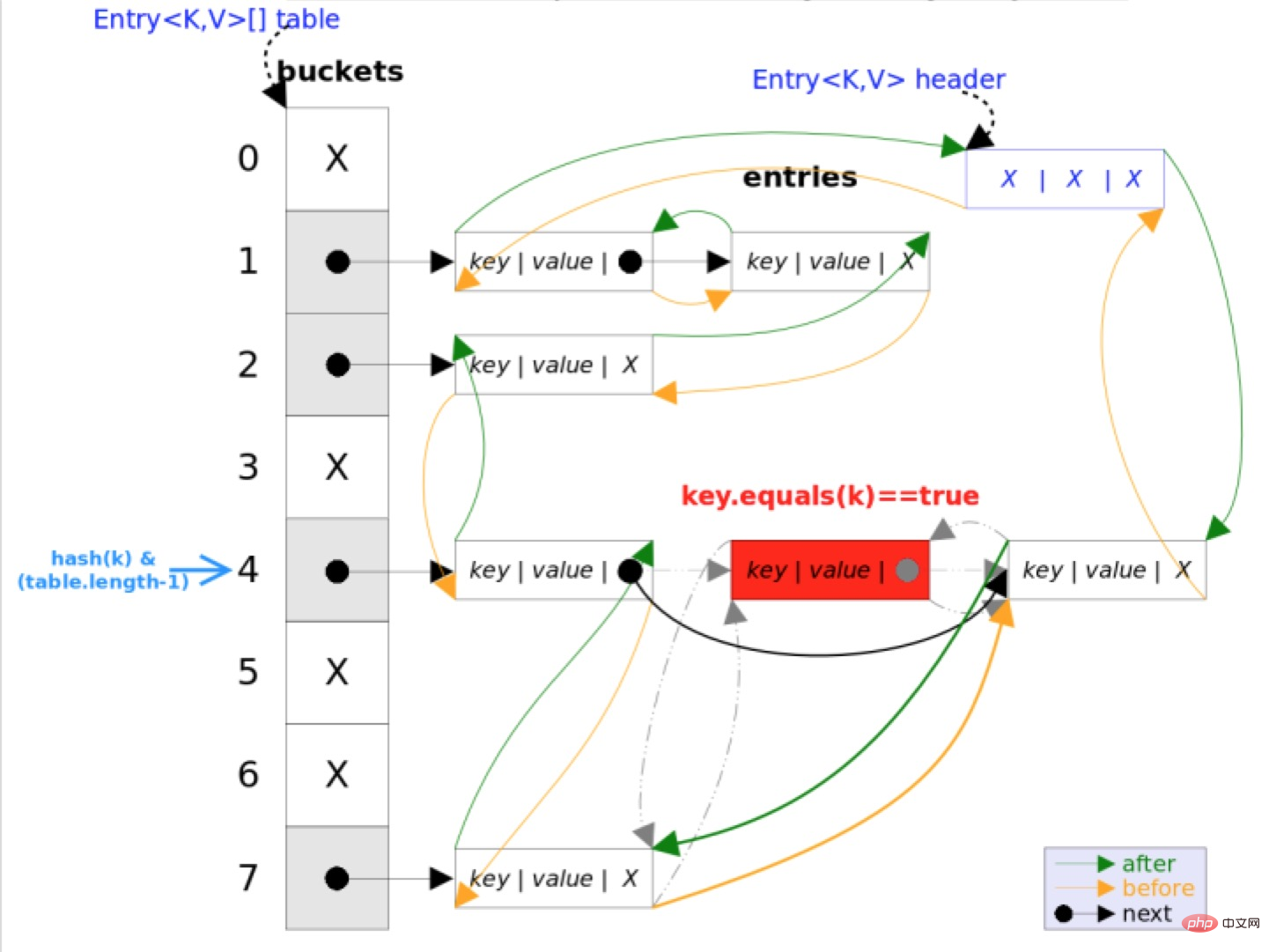
一、摘要
#在集合系列的第一章,咱們了解到,Map的實作類別有HashMap、LinkedHashMap、TreeMap、IdentityHashMap、WeakHashMap、Hashtable、Properties等等。

本文主要從資料結構與演算法層面,探討LinkedHashMap的實作。
(推薦學習:Java影片教學#)
二、簡介
LinkedHashMap可以認為是HashMap LinkedList,它既使用HashMap操作資料結構,也使用LinkedList維護插入元素的先後順序,內部採用雙向鍊錶(doubly-linked list)的形式將所有元素( entry )連結起來。
LinkedHashMap繼承了HashMap,允許放入key為null的元素,也允許插入value為null的元素。從名字上可以看出該容器是LinkedList和HashMap的混合體,也就是說它同時滿足HashMap和LinkedList的某些特性,可將LinkedHashMap看作採用Linked list增強的HashMap。
開啟LinkedHashMap 原始碼,可以看到主要三個核心屬性:
public class LinkedHashMap<K,V>
extends HashMap<K,V>
implements Map<K,V>{
/**双向链表的头节点*/
transient LinkedHashMap.Entry<K,V> head;
/**双向链表的尾节点*/
transient LinkedHashMap.Entry<K,V> tail;
/**
* 1、如果accessOrder为true的话,则会把访问过的元素放在链表后面,放置顺序是访问的顺序
* 2、如果accessOrder为false的话,则按插入顺序来遍历
*/
final boolean accessOrder;
}LinkedHashMap 在初始化階段,預設按插入順序來遍歷
public LinkedHashMap() {
super();
accessOrder = false;
}LinkedHashMap 採用的Hash 演算法和HashMap 相同,不同的是,它重新定義了數組中保存的元素Entry,該Entry除了保存當前對象的引用外,還保存了其上一個元素before和下一個元素after的引用,從而在哈希表的基礎上又構成了雙向連結列表。
原始碼如下:
static class Entry<K,V> extends HashMap.Node<K,V> {
//before指的是链表前驱节点,after指的是链表后驱节点
Entry<K,V> before, after;
Entry(int hash, K key, V value, Node<K,V> next) {
super(hash, key, value, next);
}
}
可以直觀的看出,雙向鍊錶頭插入的資料為鍊錶的入口,迭代器遍歷方向是從鍊錶的頭部開始到鍊錶尾部結束。

除了可以保迭代歷順序,這種結構還有一個好處:迭代LinkedHashMap時不需要像HashMap那樣遍歷整個table,而只需要直接遍歷header指向的雙向鍊錶即可,也就是說LinkedHashMap的迭代時間就只跟entry的數量相關,而跟table的大小無關。
三、常用方法介紹
3.1、get方法
get方法根據指定的key值傳回對應的value 。此方法跟HashMap.get()方法的流程幾乎完全一樣,預設按照插入順序遍歷。
public V get(Object key) {
Node<K,V> e;
if ((e = getNode(hash(key), key)) == null)
return null;
if (accessOrder)
afterNodeAccess(e);
return e.value;
}如果accessOrder為true的話,會把訪問過的元素放在鍊錶後面,放置順序是訪問的順序
void afterNodeAccess(Node<K,V> e) { // move node to last
LinkedHashMap.Entry<K,V> last;
if (accessOrder && (last = tail) != e) {
LinkedHashMap.Entry<K,V> p =
(LinkedHashMap.Entry<K,V>)e, b = p.before, a = p.after;
p.after = null;
if (b == null)
head = a;
else
b.after = a;
if (a != null)
a.before = b;
else
last = b;
if (last == null)
head = p;
else {
p.before = last;
last.after = p;
}
tail = p;
++modCount;
}
}測試案例:
public static void main(String[] args) {
//accessOrder默认为false
Map<String, String> accessOrderFalse = new LinkedHashMap<>();
accessOrderFalse.put("1","1");
accessOrderFalse.put("2","2");
accessOrderFalse.put("3","3");
accessOrderFalse.put("4","4");
System.out.println("acessOrderFalse:"+accessOrderFalse.toString());
//accessOrder设置为true
Map<String, String> accessOrderTrue = new LinkedHashMap<>(16, 0.75f, true);
accessOrderTrue.put("1","1");
accessOrderTrue.put("2","2");
accessOrderTrue.put("3","3");
accessOrderTrue.put("4","4");
accessOrderTrue.get("2");//获取键2
accessOrderTrue.get("3");//获取键3
System.out.println("accessOrderTrue:"+accessOrderTrue.toString());
}輸出結果:
acessOrderFalse:{1=1, 2=2, 3=3, 4=4}
accessOrderTrue:{1=1, 4=4, 2=2, 3=3}3.2、put方法
put(K key, V value)方法是將指定的key, value對加入到map裡。此方法首先會呼叫HashMap的插入方法,同樣對map做一次查找,看是否包含該元素,如果已經包含則直接傳回,查找過程類似於get()方法;如果沒有找到,將元素插入集合。
/**HashMap 中实现*/
public V put(K key, V value) {
return putVal(hash(key), key, value, false, true);
}
final V putVal(int hash, K key, V value, boolean onlyIfAbsent,
boolean evict) {
Node<K,V>[] tab; Node<K,V> p; int n, i;
if ((tab = table) == null || (n = tab.length) == 0)
n = (tab = resize()).length;
if ((p = tab[i = (n - 1) & hash]) == null)
tab[i] = newNode(hash, key, value, null);
else {
Node<K,V> e; K k;
if (p.hash == hash &&
((k = p.key) == key || (key != null && key.equals(k))))
e = p;
else if (p instanceof TreeNode)
e = ((TreeNode<K,V>)p).putTreeVal(this, tab, hash, key, value);
else {
for (int binCount = 0; ; ++binCount) {
if ((e = p.next) == null) {
p.next = newNode(hash, key, value, null);
if (binCount >= TREEIFY_THRESHOLD - 1) // -1 for 1st
treeifyBin(tab, hash);
break;
}
if (e.hash == hash &&
((k = e.key) == key || (key != null && key.equals(k))))
break;
p = e;
}
}
if (e != null) { // existing mapping for key
V oldValue = e.value;
if (!onlyIfAbsent || oldValue == null)
e.value = value;
afterNodeAccess(e);
return oldValue;
}
}
++modCount;
if (++size > threshold)
resize();
afterNodeInsertion(evict);
return null;
}LinkedHashMap 中已覆寫的方法
// LinkedHashMap 中覆写
Node<K,V> newNode(int hash, K key, V value, Node<K,V> e) {
LinkedHashMap.Entry<K,V> p =
new LinkedHashMap.Entry<K,V>(hash, key, value, e);
// 将 Entry 接在双向链表的尾部
linkNodeLast(p);
return p;
}
private void linkNodeLast(LinkedHashMap.Entry<K,V> p) {
LinkedHashMap.Entry<K,V> last = tail;
tail = p;
// last 为 null,表明链表还未建立
if (last == null)
head = p;
else {
// 将新节点 p 接在链表尾部
p.before = last;
last.after = p;
}
}
3.3、remove方法
#remove(Object key)的作用是刪除key值對應的entry,方法實作邏輯主要以HashMap為主,先找到key值對應的entry,然後刪除該entry(修改鍊錶的對應參考),找出過程跟get()方法類似,最後會呼叫LinkedHashMap 中覆寫的方法,將其刪除!
/**HashMap 中实现*/
public V remove(Object key) {
Node<K,V> e;
return (e = removeNode(hash(key), key, null, false, true)) == null ?
null : e.value;
}
final Node<K,V> removeNode(int hash, Object key, Object value,
boolean matchValue, boolean movable) {
Node<K,V>[] tab; Node<K,V> p; int n, index;
if ((tab = table) != null && (n = tab.length) > 0 &&
(p = tab[index = (n - 1) & hash]) != null) {
Node<K,V> node = null, e; K k; V v;
if (p.hash == hash &&
((k = p.key) == key || (key != null && key.equals(k))))
node = p;
else if ((e = p.next) != null) {
if (p instanceof TreeNode) {...}
else {
// 遍历单链表,寻找要删除的节点,并赋值给 node 变量
do {
if (e.hash == hash &&
((k = e.key) == key ||
(key != null && key.equals(k)))) {
node = e;
break;
}
p = e;
} while ((e = e.next) != null);
}
}
if (node != null && (!matchValue || (v = node.value) == value ||
(value != null && value.equals(v)))) {
if (node instanceof TreeNode) {...}
// 将要删除的节点从单链表中移除
else if (node == p)
tab[index] = node.next;
else
p.next = node.next;
++modCount;
--size;
afterNodeRemoval(node); // 调用删除回调方法进行后续操作
return node;
}
}
return null;
}LinkedHashMap 中覆寫的afterNodeRemoval 方法
void afterNodeRemoval(Node<K,V> e) { // unlink
LinkedHashMap.Entry<K,V> p =
(LinkedHashMap.Entry<K,V>)e, b = p.before, a = p.after;
// 将 p 节点的前驱后后继引用置空
p.before = p.after = null;
// b 为 null,表明 p 是头节点
if (b == null)
head = a;
else
b.after = a;
// a 为 null,表明 p 是尾节点
if (a == null)
tail = b;
else
a.before = b;
}
四、總結
LinkedHashMap 繼承自HashMap,所有大部分功能特性基本上相同,二者唯一的區別是LinkedHashMap 在HashMap的基礎上,採用雙向鍊錶(doubly-linked list)的形式將所有entry 連接起來,這樣是為保證元素的迭代順序跟插入順序相同。
主體部分跟HashMap完全一樣,多了header指向雙向鍊錶的頭部,tail指向雙向鍊錶的尾部,預設雙向鍊錶的迭代順序就是entry的插入順序。
This article comes from php Chinese website, java tutorial column, welcome to learn!
以上是深入淺出分析LinkedHashMap(圖文)的詳細內容。更多資訊請關注PHP中文網其他相關文章!



